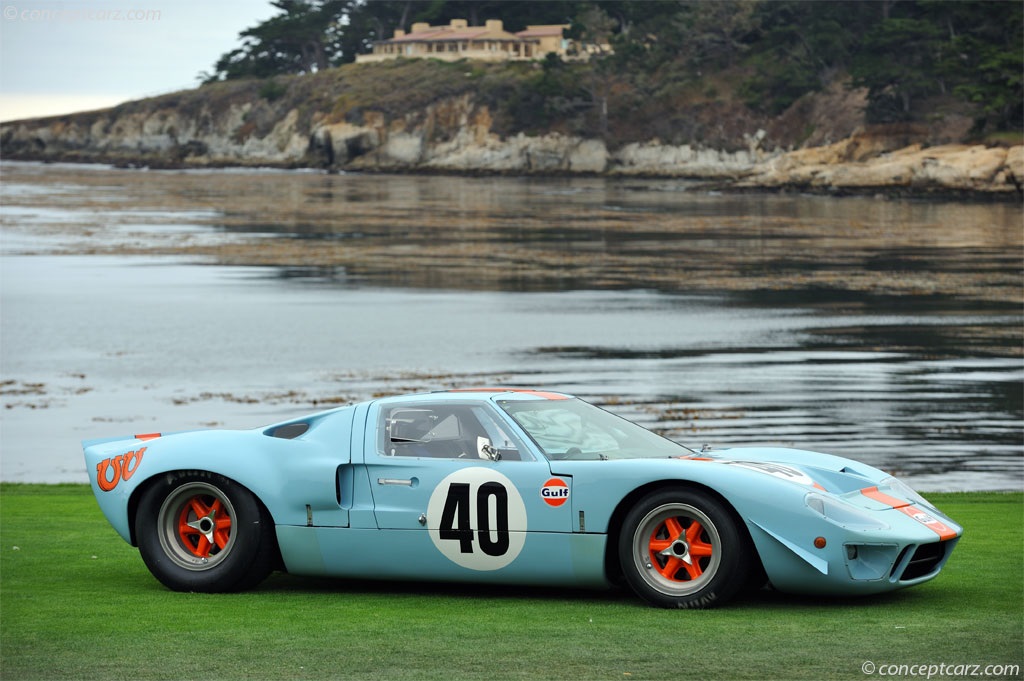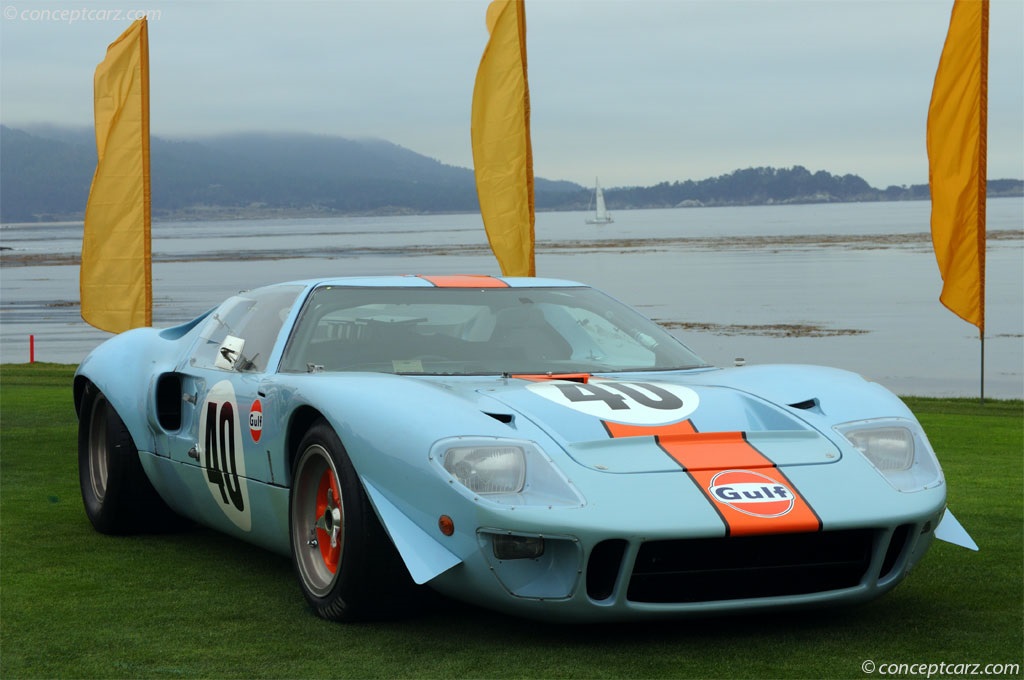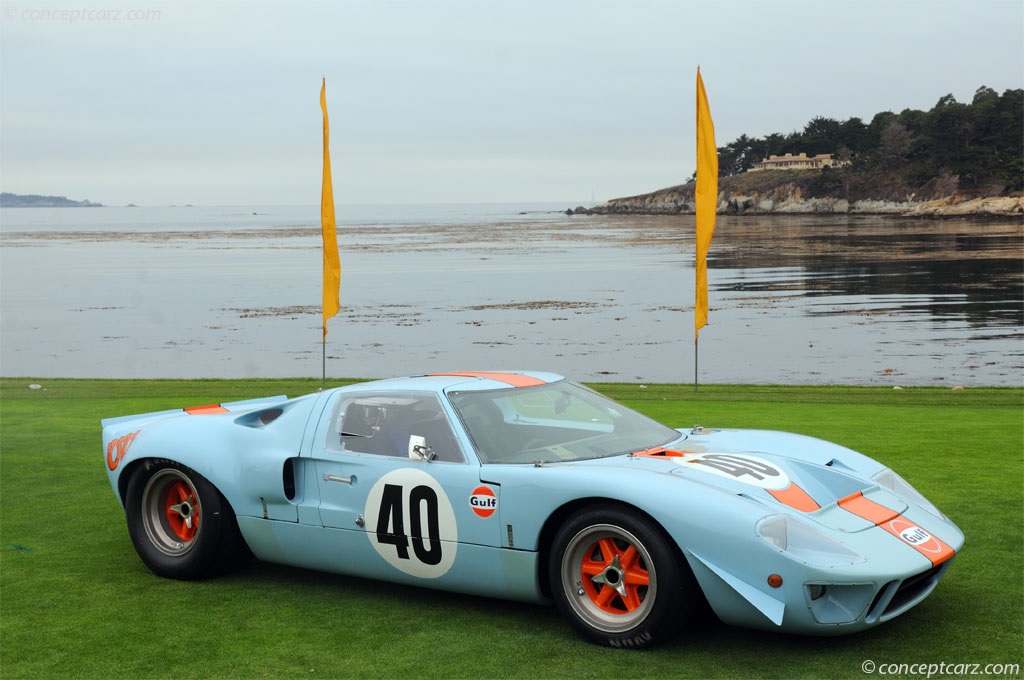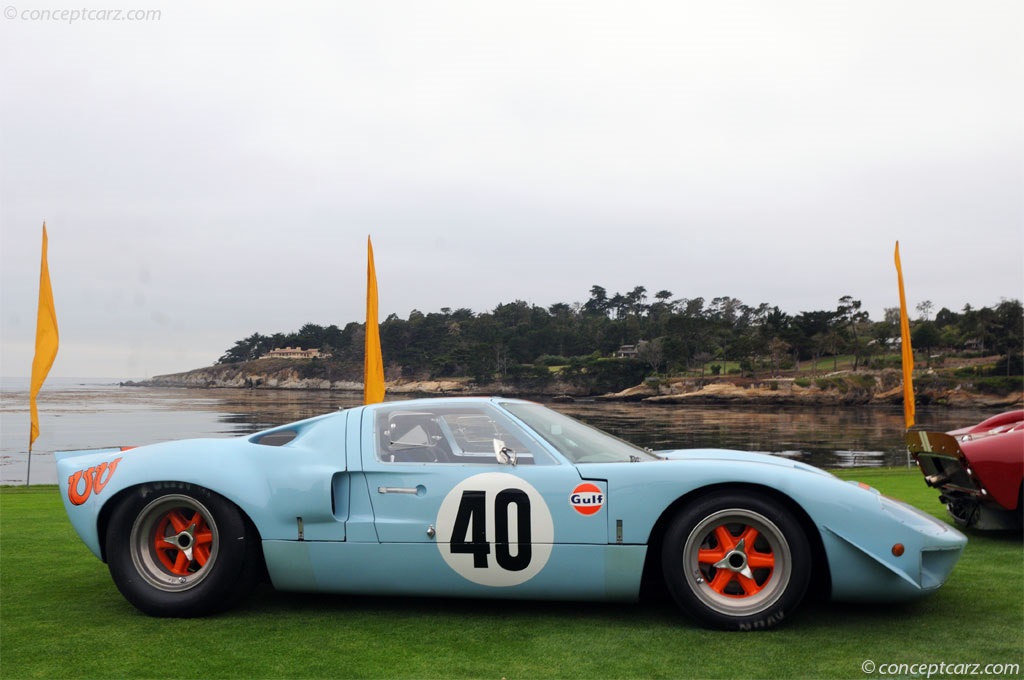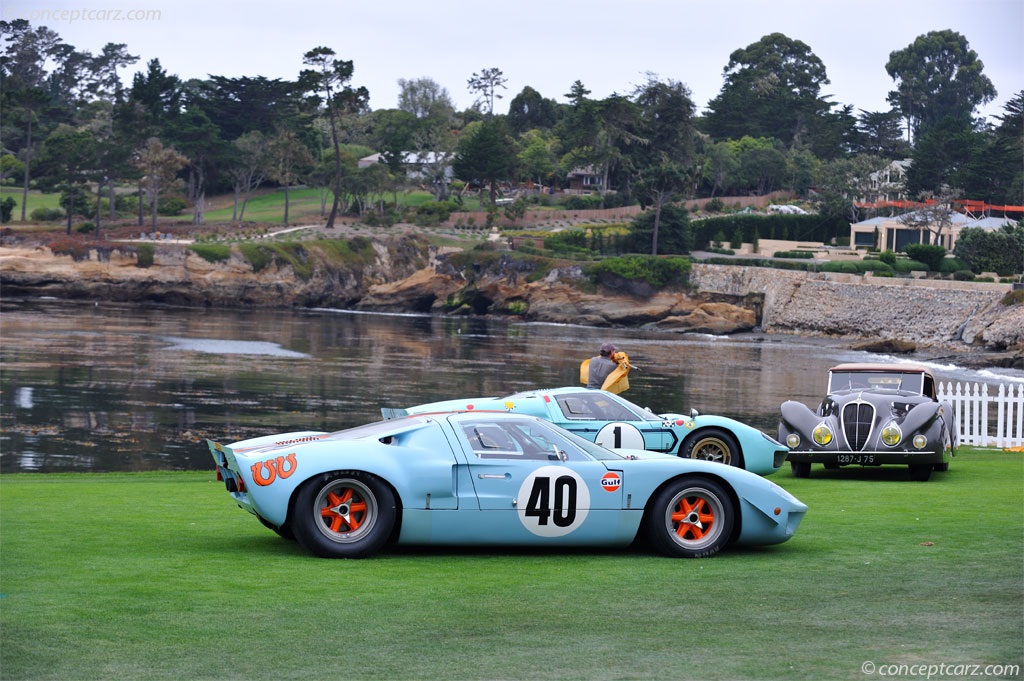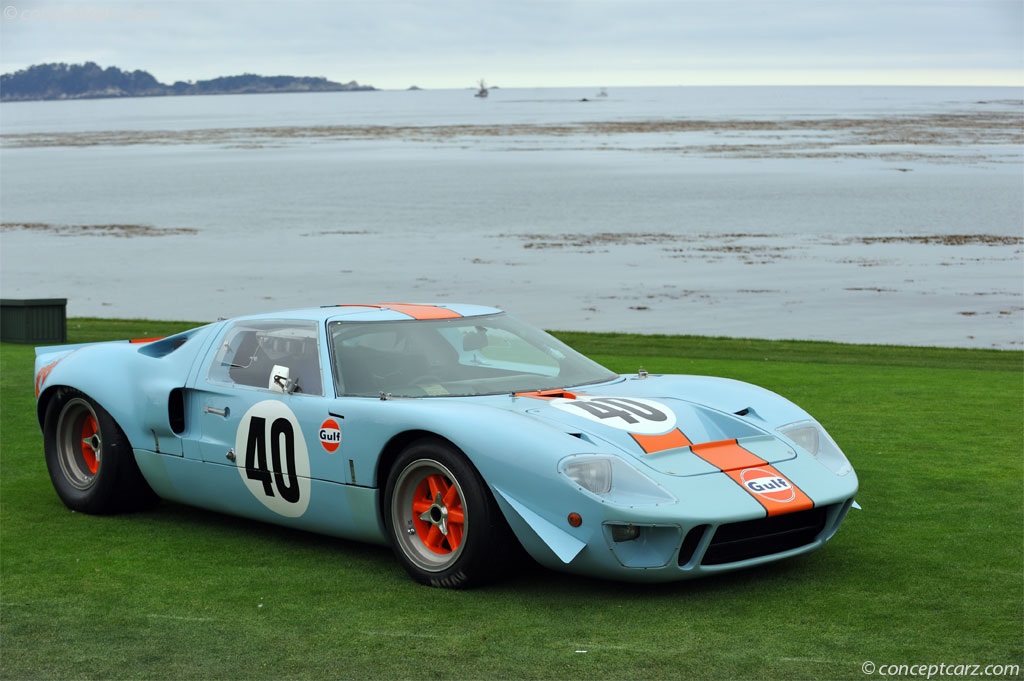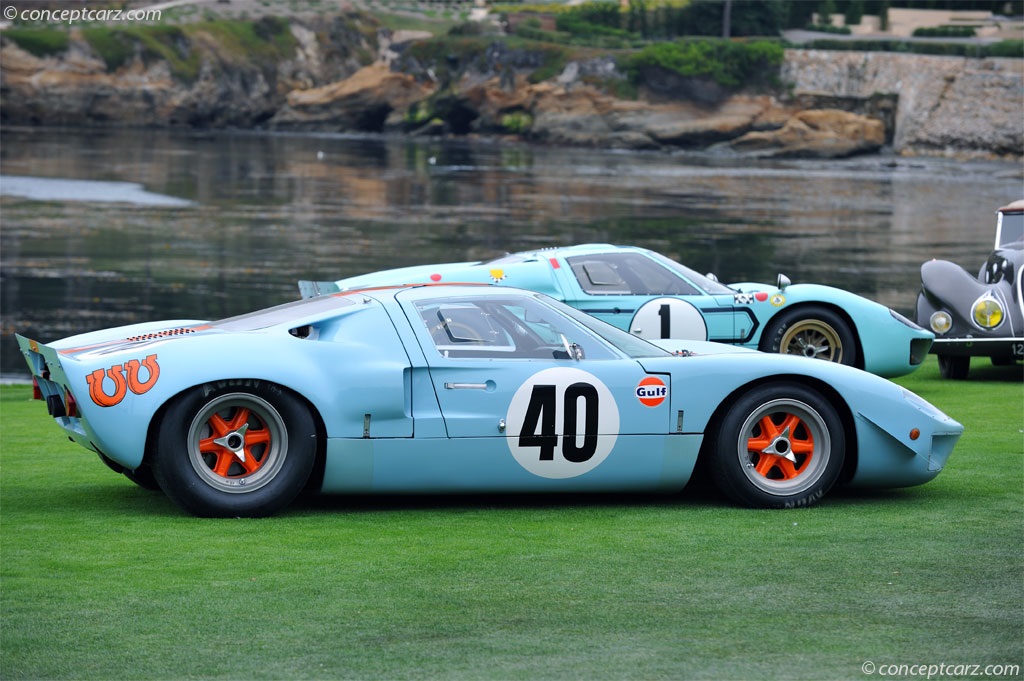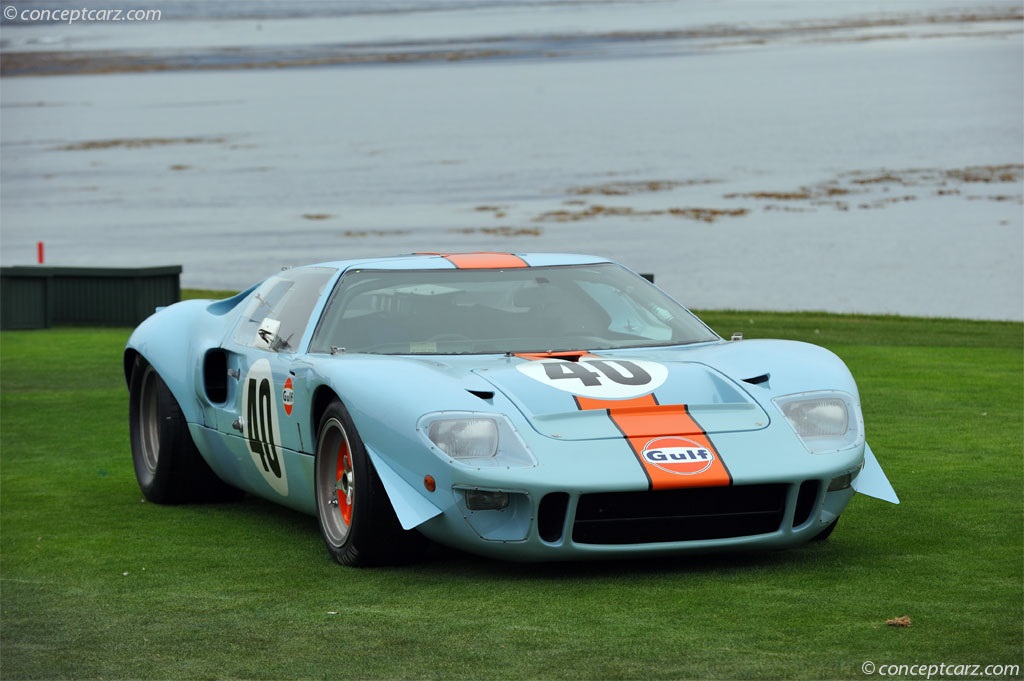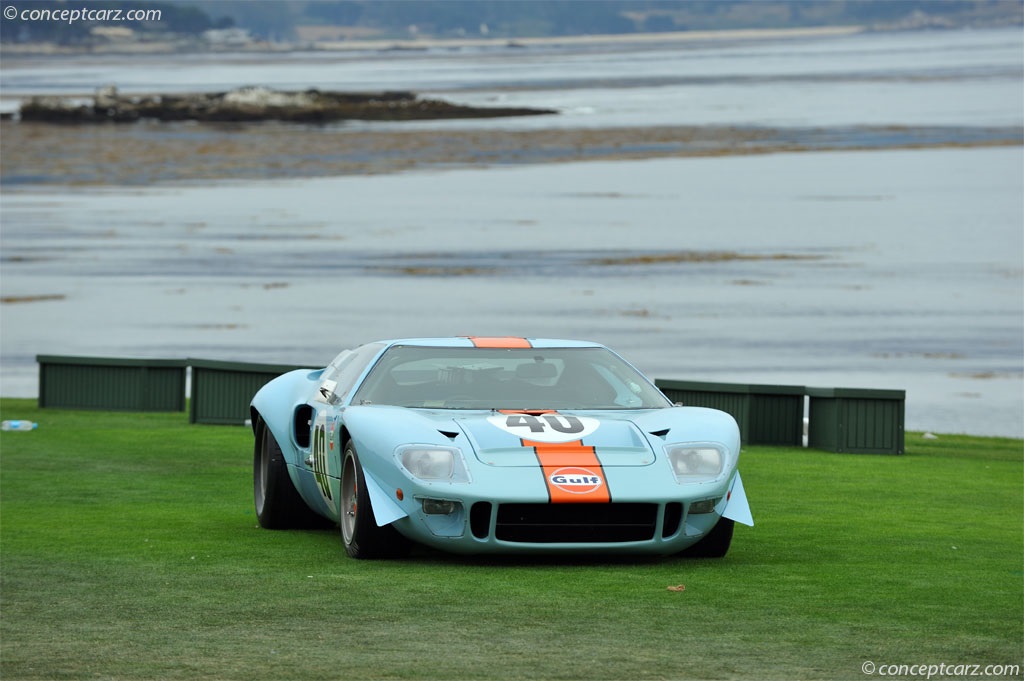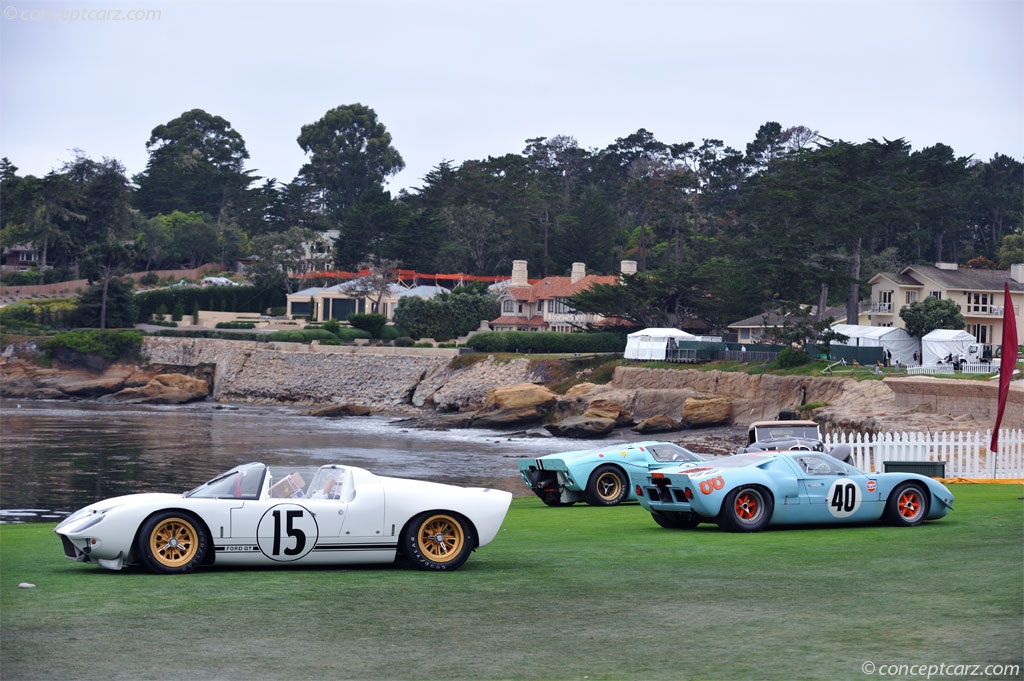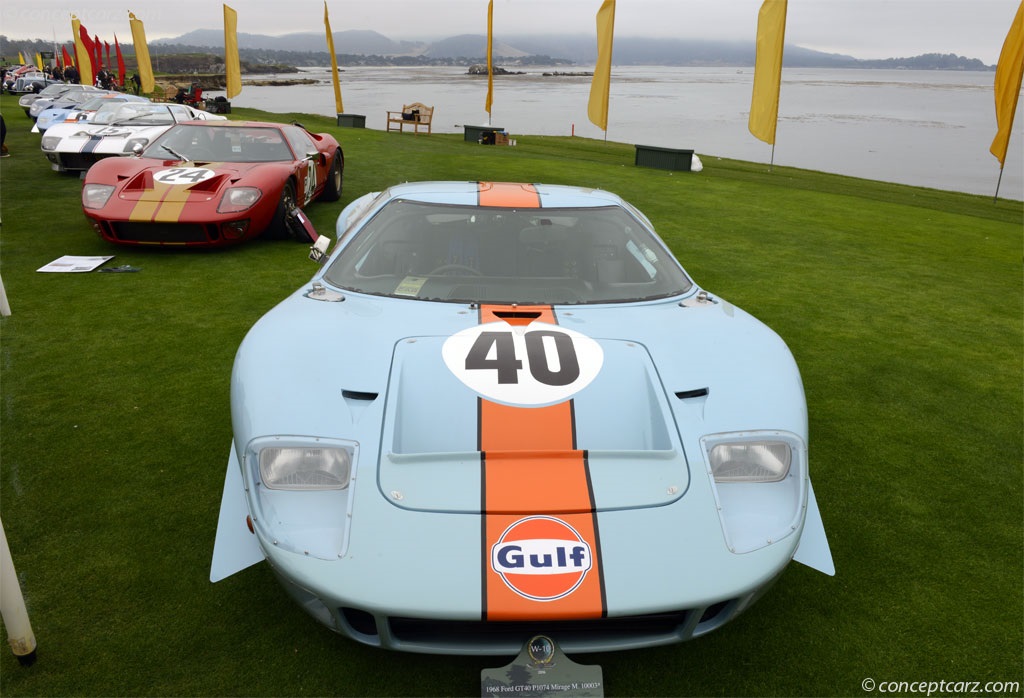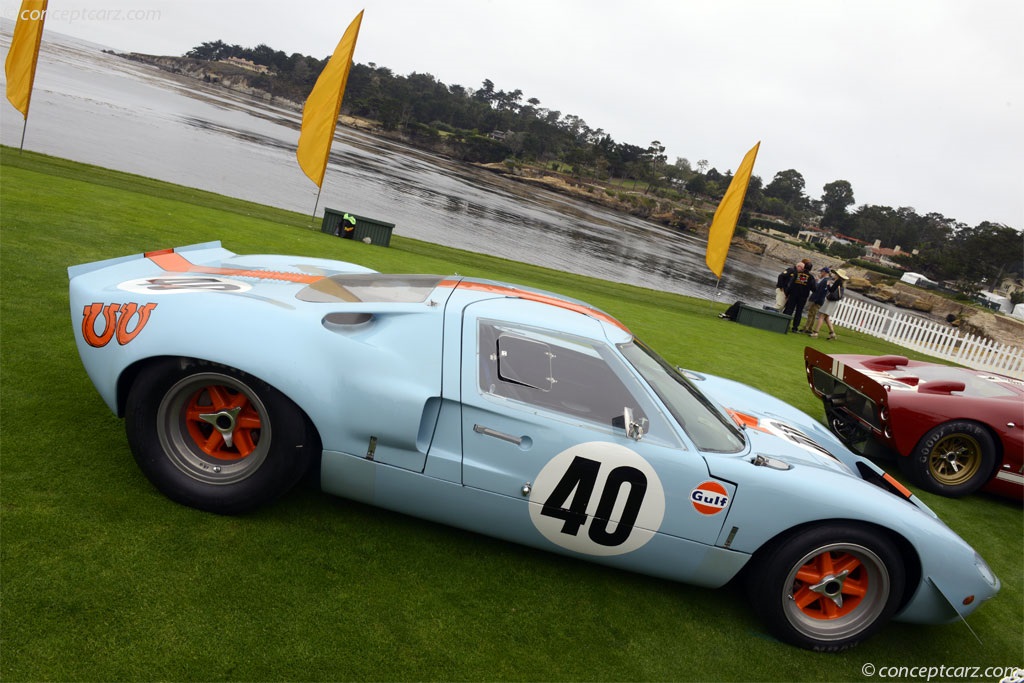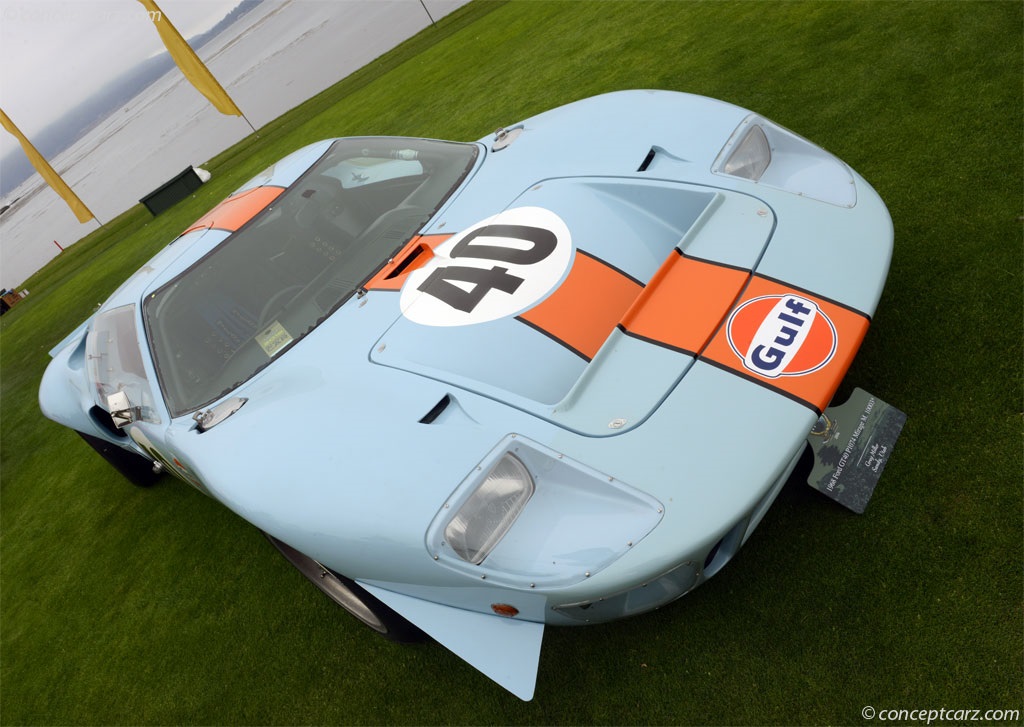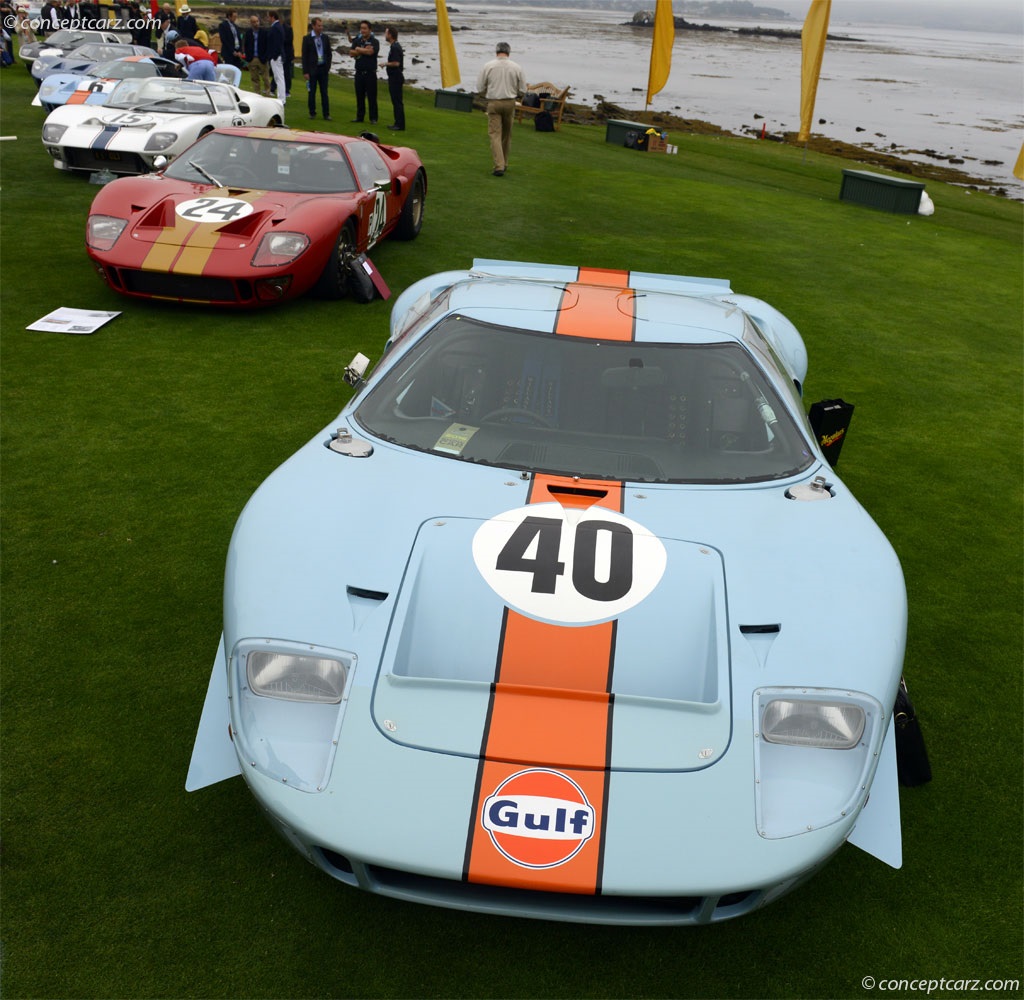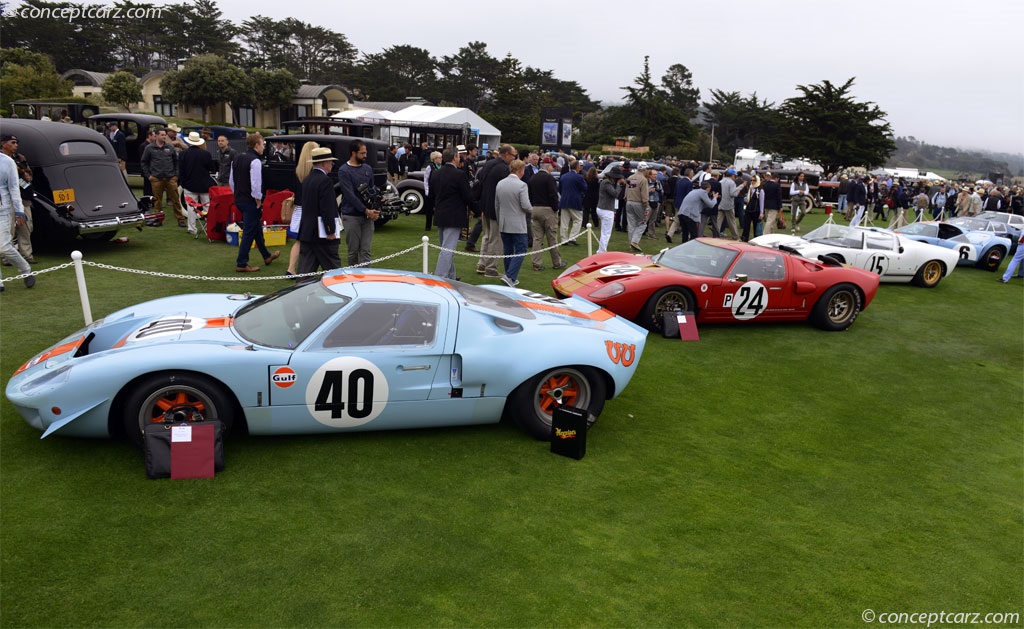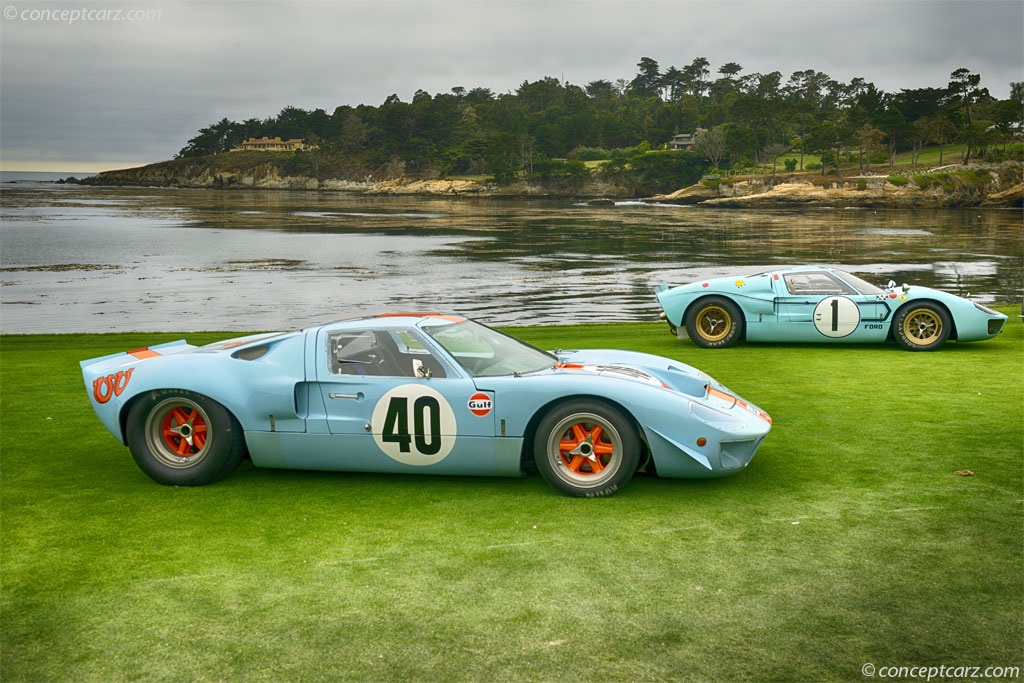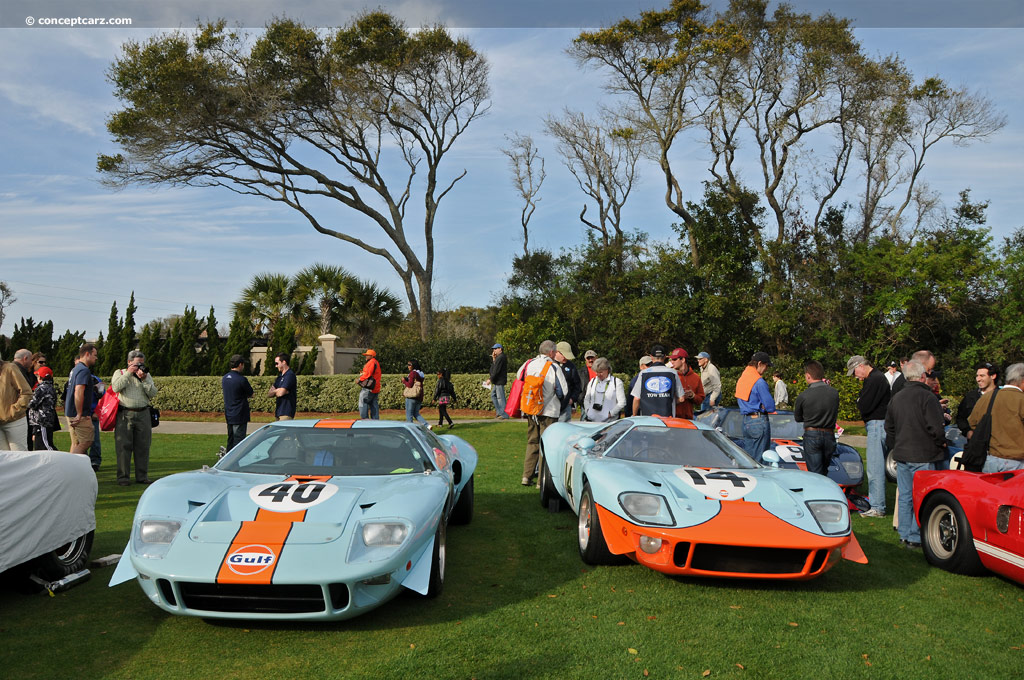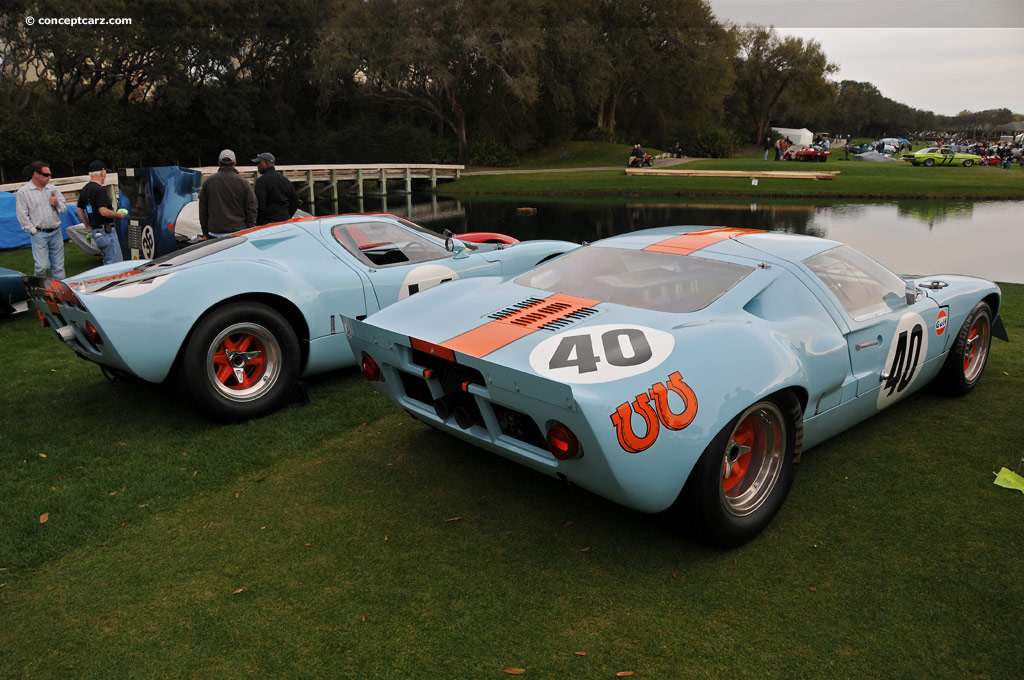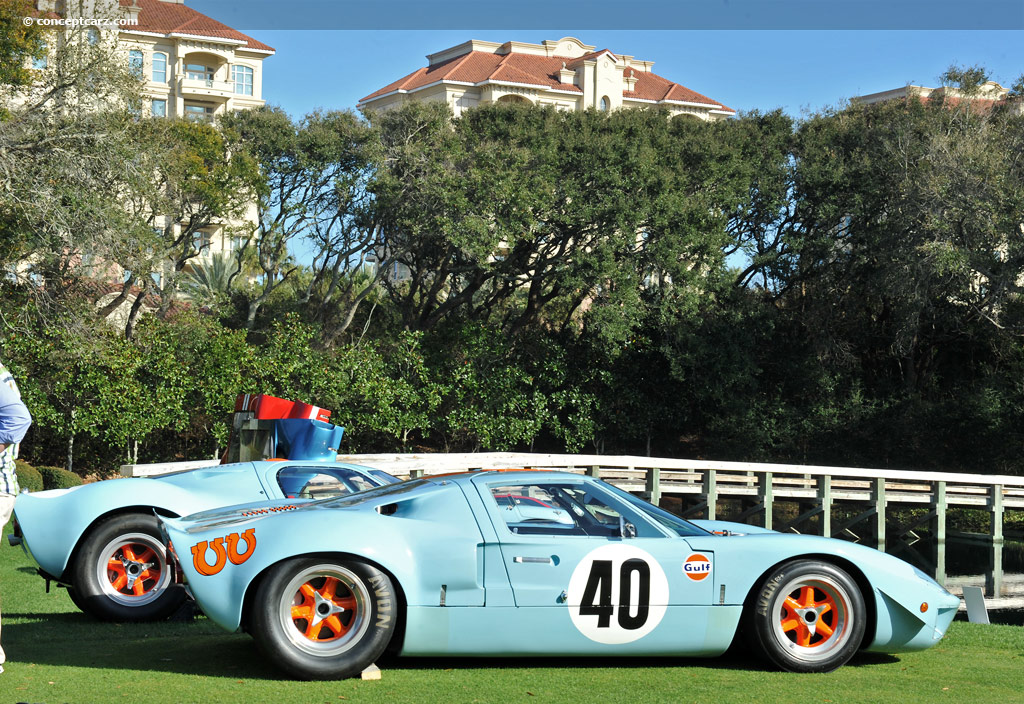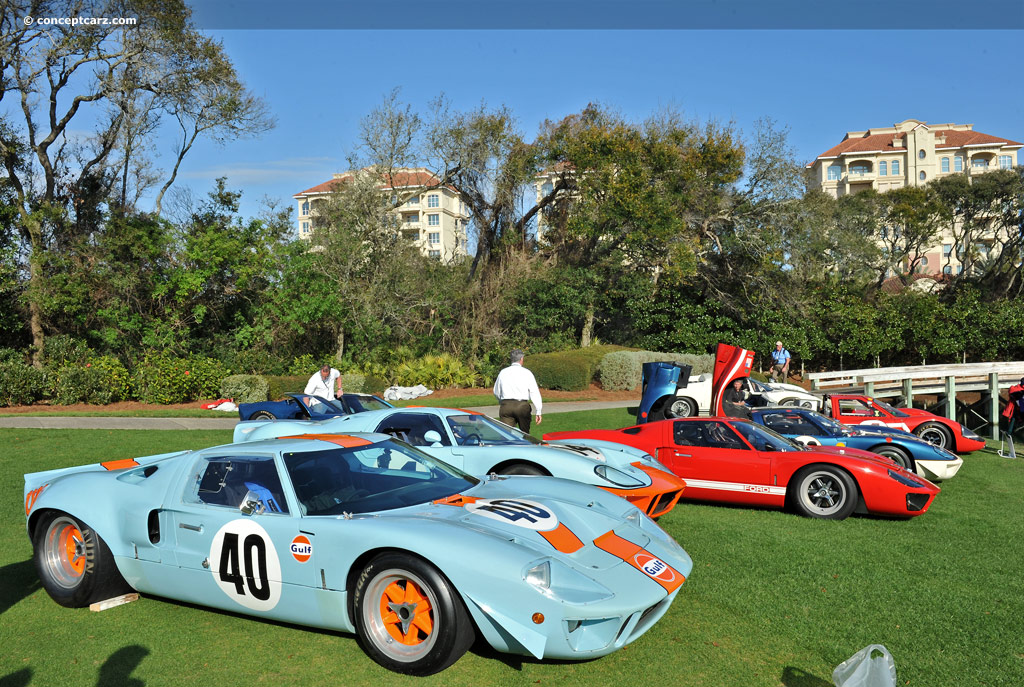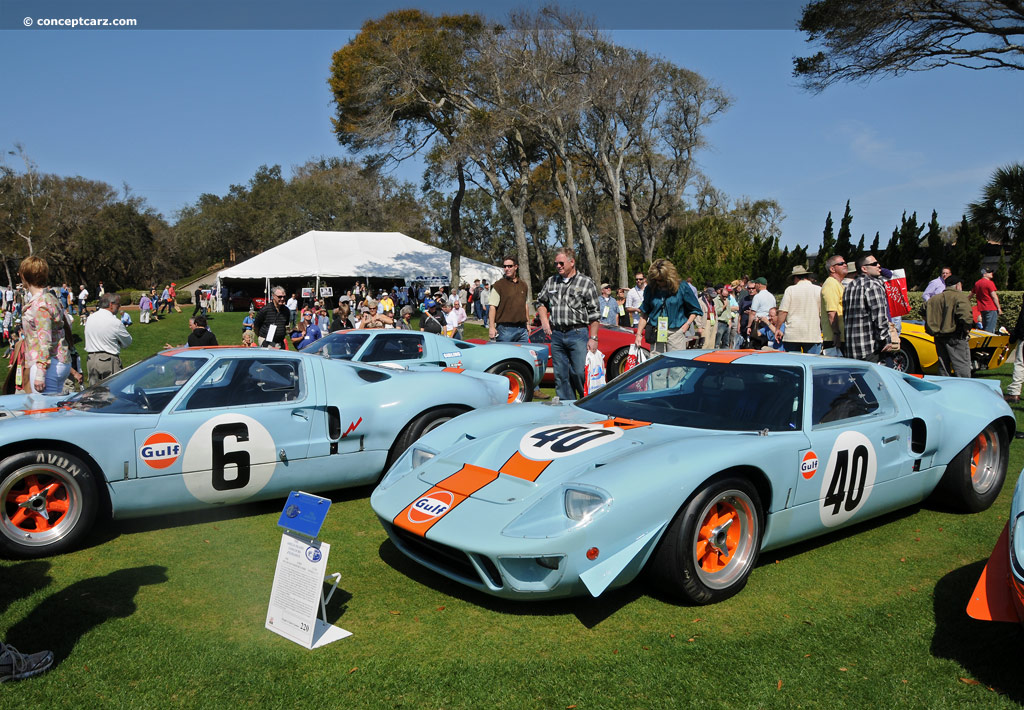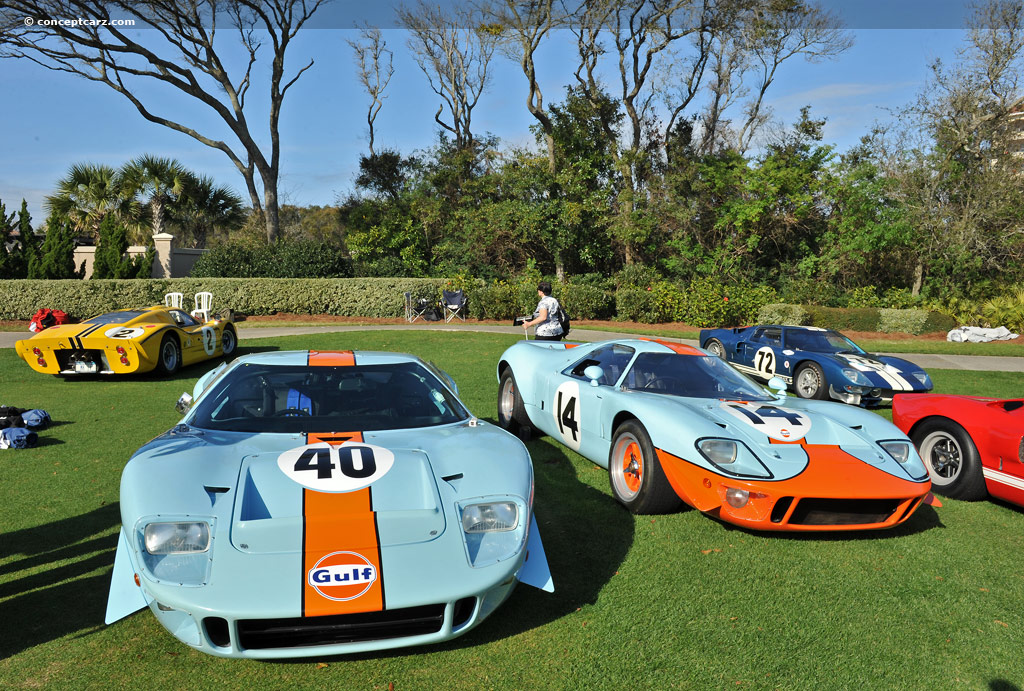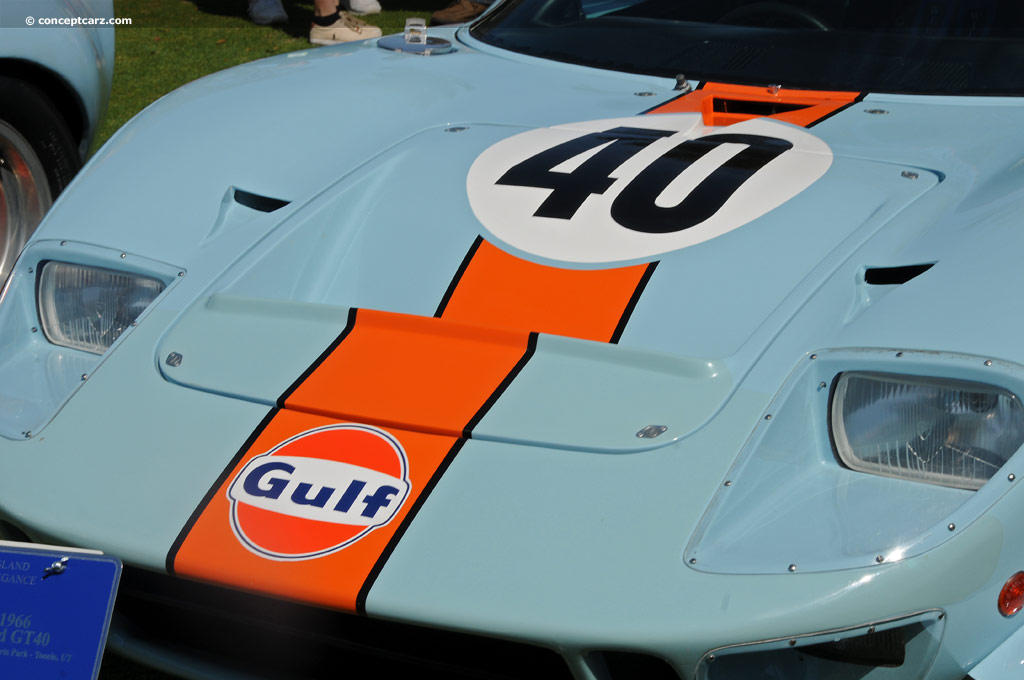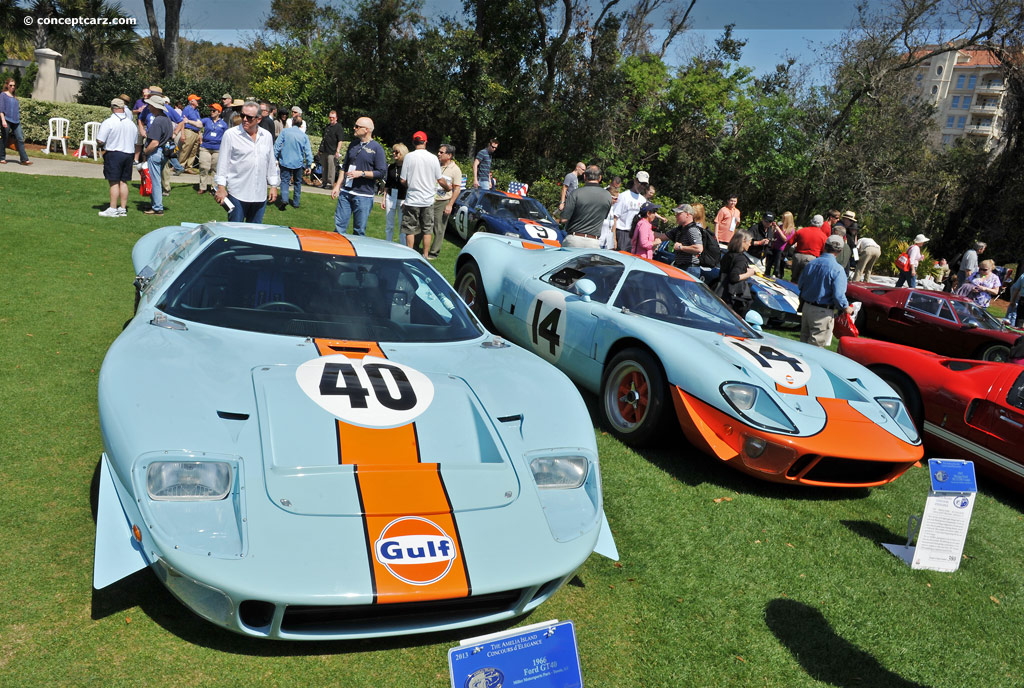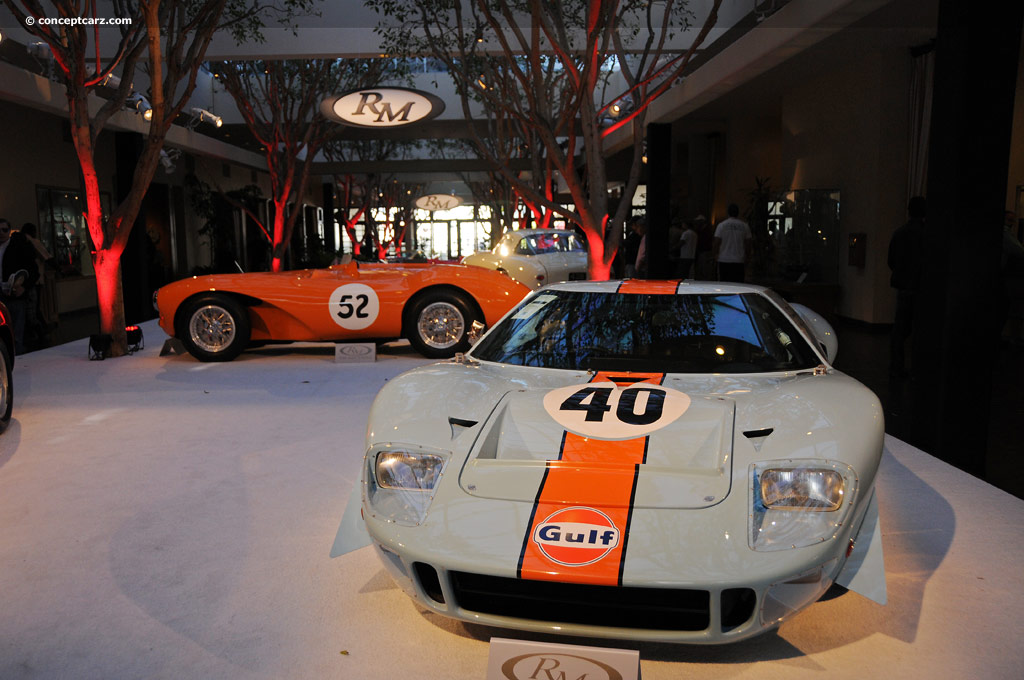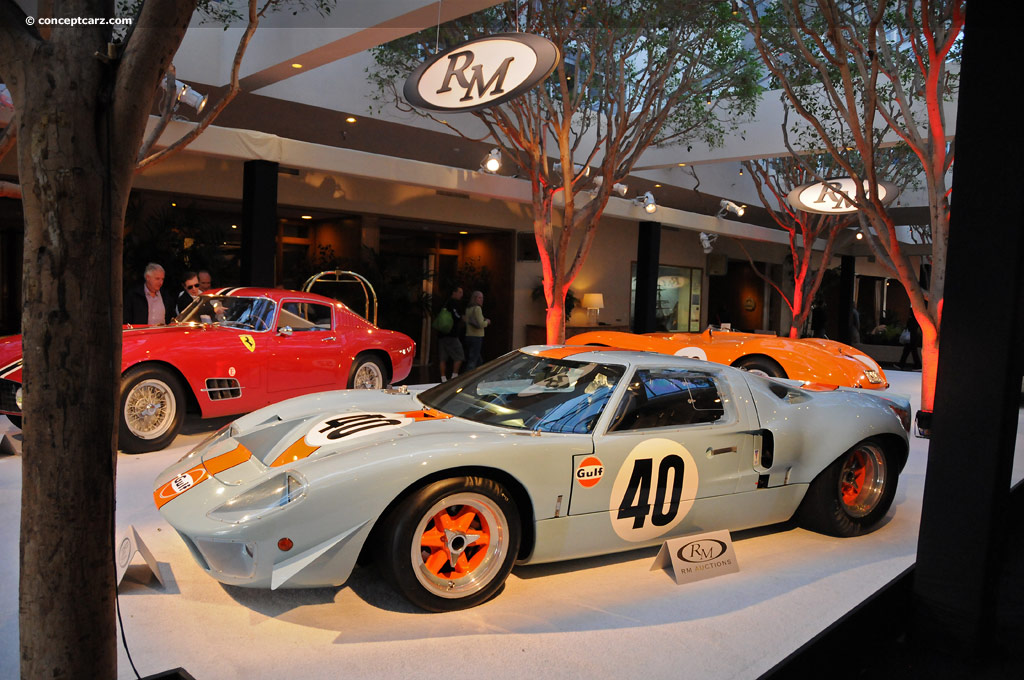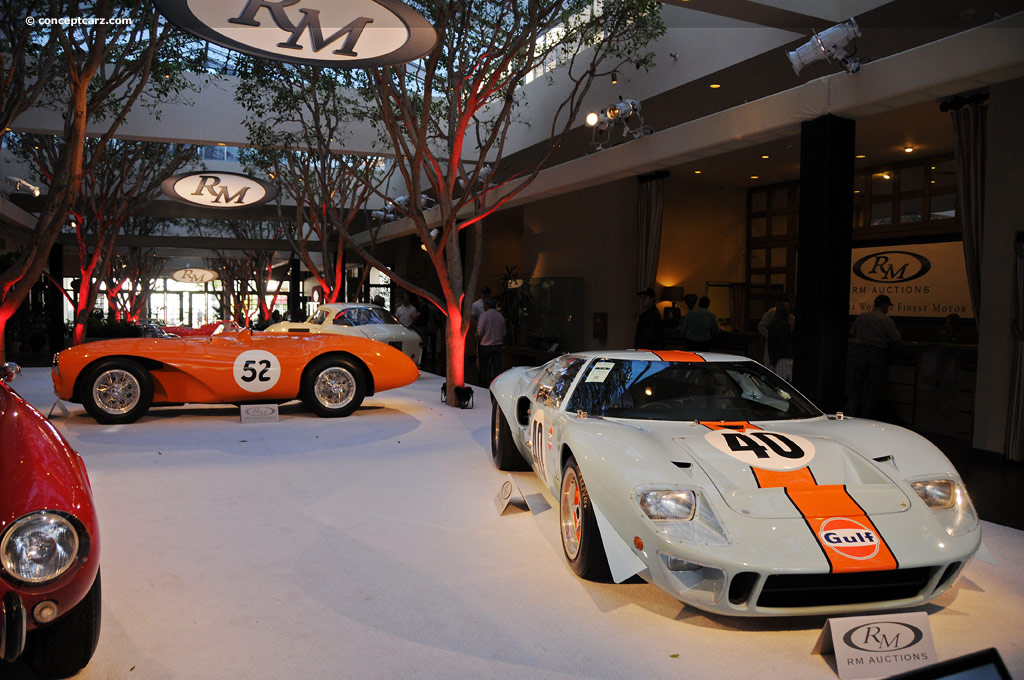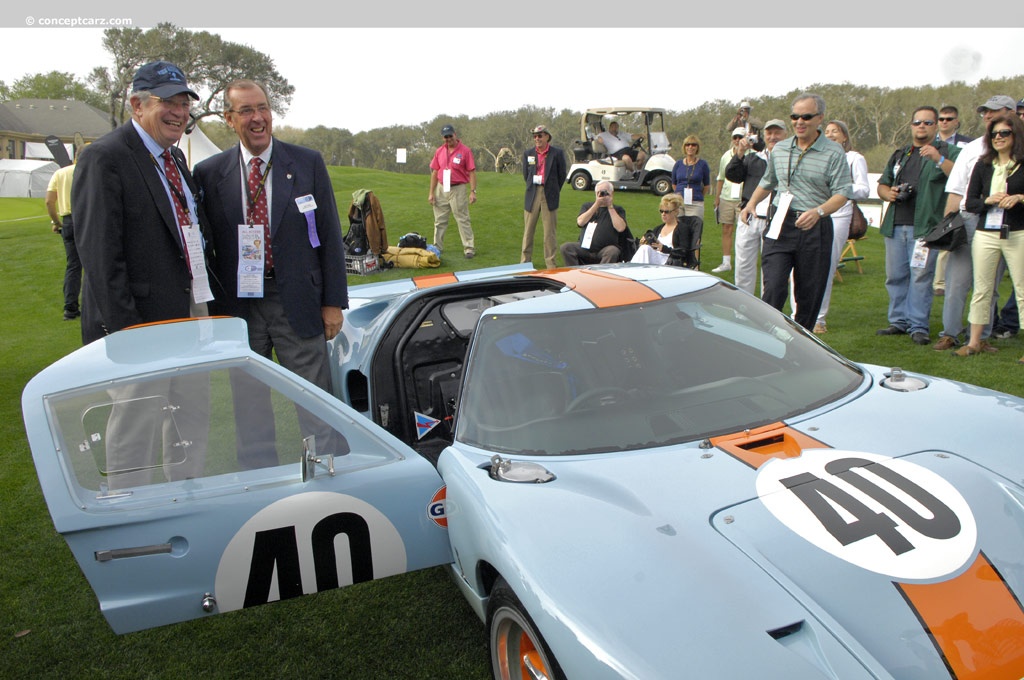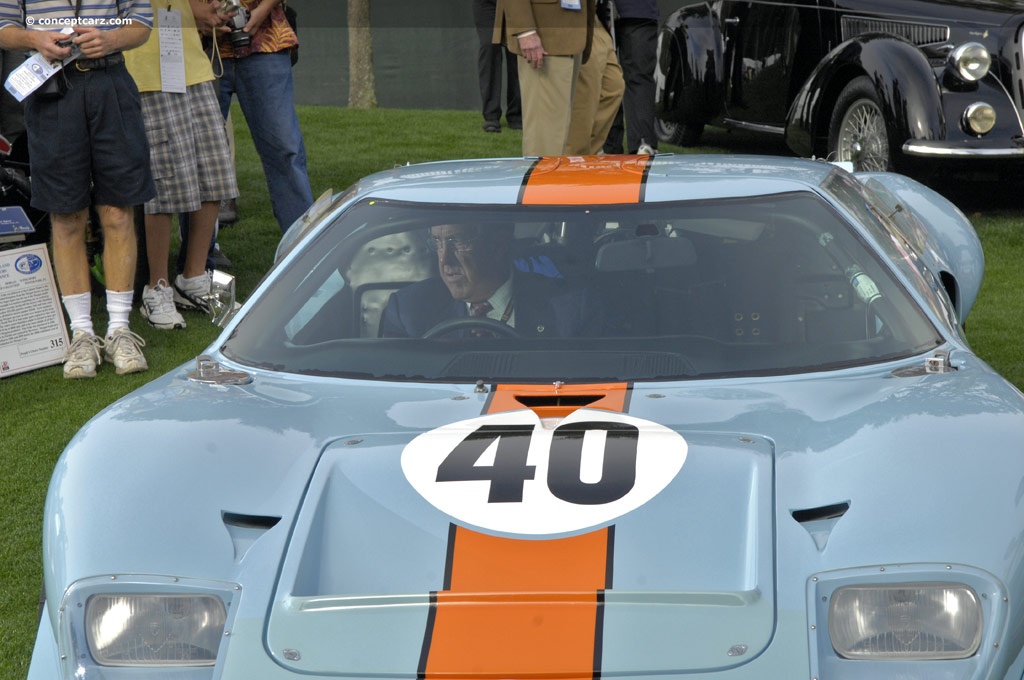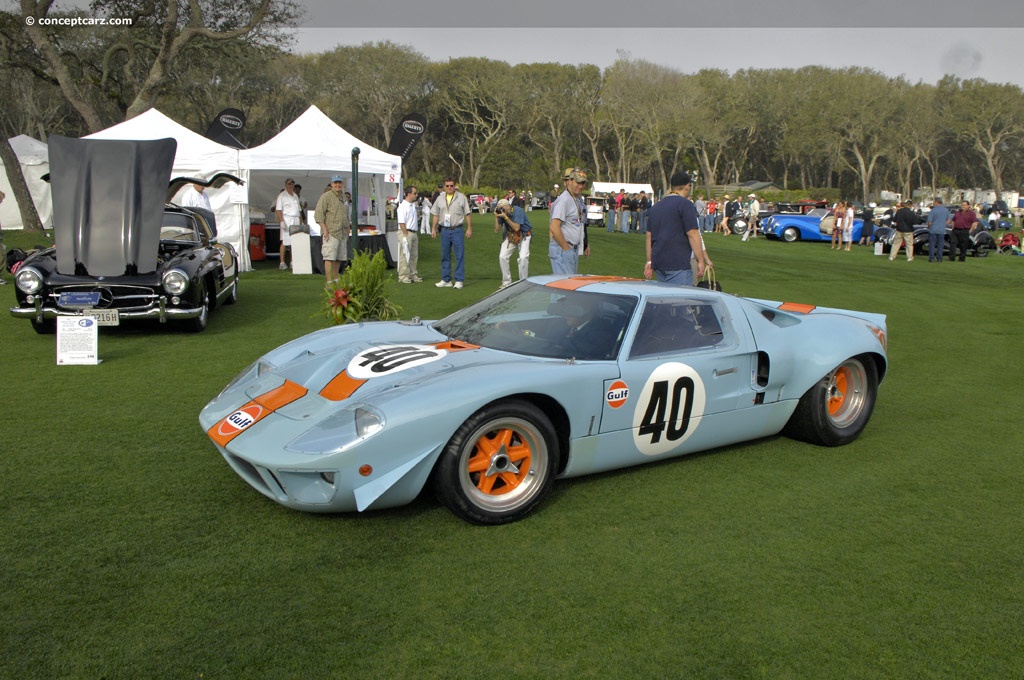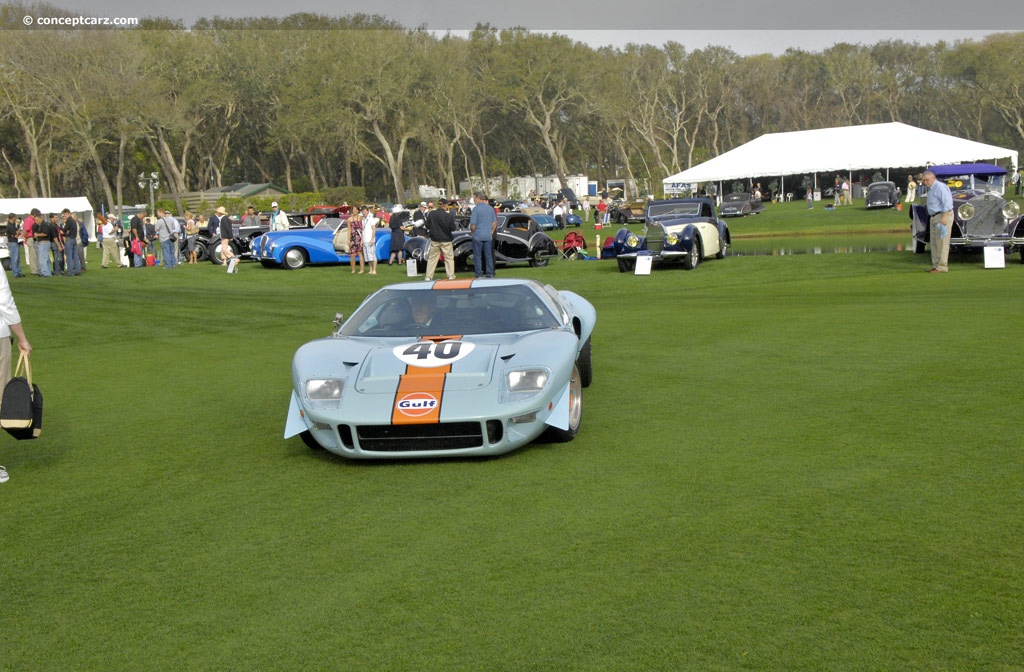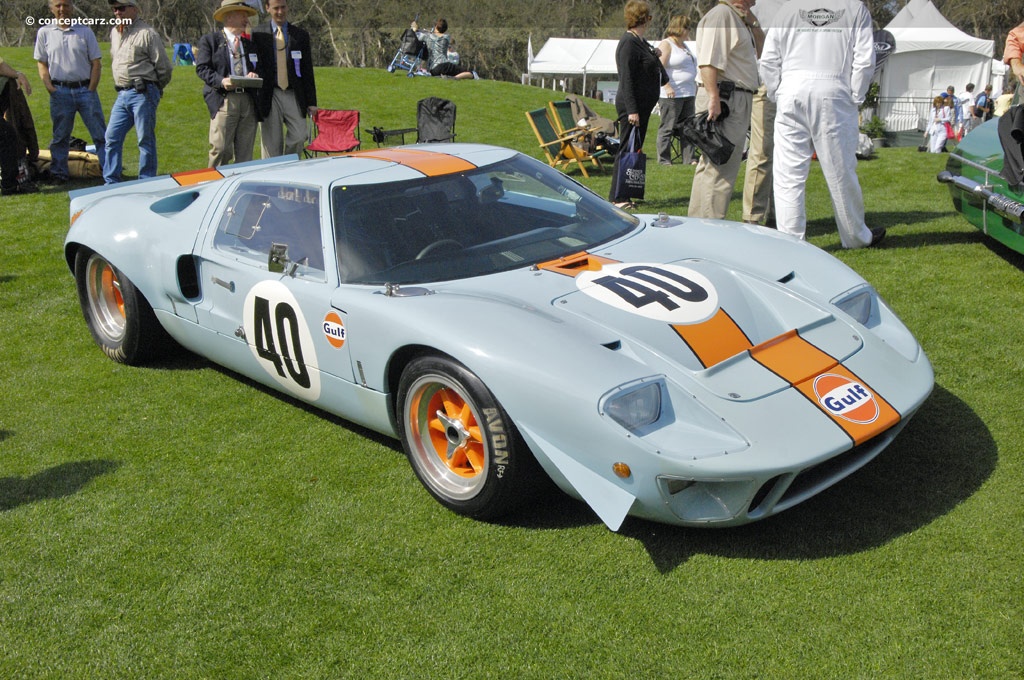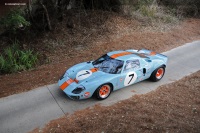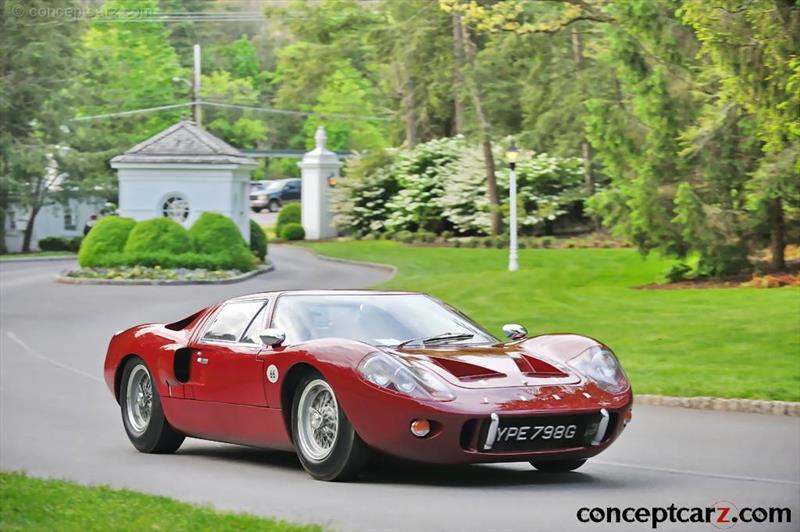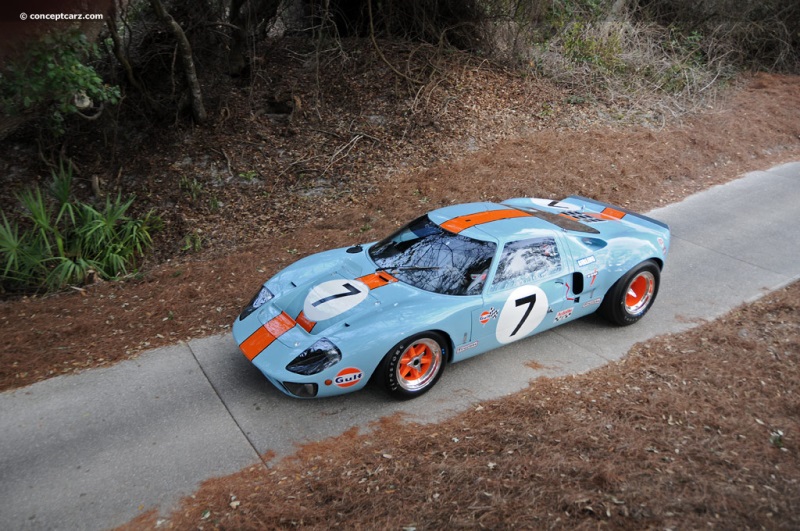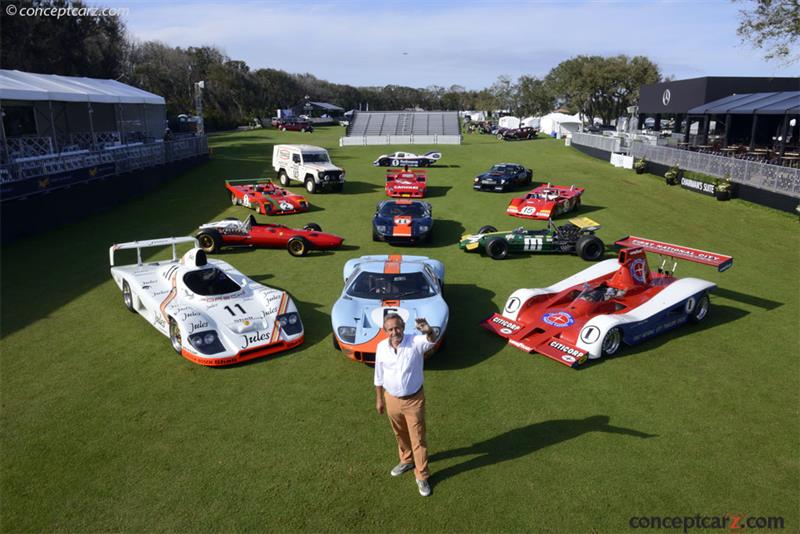Image credit: © conceptcarz.com (Reproduction Or reuse prohibited).
To construct the first race car to bear the name Mirage and sponsored by Gulf Oil, a standard GT40 chassis frame was drawn from stock. When they finished, only the sill panels remained unchanged from the original. Three such cars, fitted with the Ford 302 cubic-inch, 5-liter engines, were ready for the 1967 season. The third M1 Mirage was completed just in time for the car to be taken to the second race of the season where it won, being driven by Jacky Ickx and Dr. Dick Thompson. At Le Mans, the car retired early with the usual Ford engine problem of cylinder head gasket failure. At the next race at Brand hatch, the Mirage was crashed after about 70 laps. This was followed by two minor races in Sweden where it won the first race driven by Ickx and a second to its sister car. In October, it was taken to Monthlhery where Ickx and Aussie Paul Hawkins drove it to another win. This concluded its life as a Mirage since prototype race cars were limited to a 3-liter engine.
Over the winter of 1967-78, the roof was cut-off again and the car reconstructed back into a GT40. As a GT40 in the World Championship series, it was less successful. David Hobbs and Paul Hawkins did win the race at Monza and came in second at Watkins Glen.
The car eventually had the top removed and it was used as a film car for the movie Le Mans starring Steve McQueen.
Over the winter of 1967-78, the roof was cut-off again and the car reconstructed back into a GT40. As a GT40 in the World Championship series, it was less successful. David Hobbs and Paul Hawkins did win the race at Monza and came in second at Watkins Glen.
The car eventually had the top removed and it was used as a film car for the movie Le Mans starring Steve McQueen.
One of the most iconic photographs of a race finish at Le Mans would have to be the famed 1966 24 Hours of Le Mans. With headlights blazing a path forward, spray kicking up on the rain-soaked front stretch and the three Ford GT40s crossing the line near in formation, no image would more emphatically declare Henry Ford II's desire to take victory and beat Ferrari.
The Ford GT40 would be special in a number of ways. Not only would it be fashioned as a result of an intense manufacturer battle, but it would also be the first to use extensive computer technology. Unfortunately, this also means the GT40 would introduce an era in motor racing in which only those with great amounts of capital could expect to achieve success. Still, the GT40 would become a truly iconic GT car.
But if the GT40 is a truly iconic endurance sportscar, then the Ford GT40 that would be made available for purchase in the 2012 RM Auctions' event at Monterey would be noted for its exceptional exploits.
Soon after Ford had come to win Le Mans with its demonstrative one-two-three victory in 1966, and then again in 1967, the Ford factory would pull its backing from the GT40 program, but development would continue. The GT40 had already introduced a number of new technologies and techniques that were befitting of Ford's desire to remake Ford's image into a more youthful one, but the innovations and technologies that would continue to be introduced on the car after the pull out of Ford would help give birth to a whole new generation in motor racing.
The chassis offered through RM at the 2012 Monterey auction would actually begin life as a Mirage and would make its debut at Spa in May of 1967. In its first race, it would be driven by a couple of legends in endurance racing. Jacky Ickx would be joined by the 'Flying Dentist' Dr. Dick Thompson and the two would pair together beautifully. In its debut, chassis M.10003 would come through to score victory. And while, at the time, the victory would not be necessarily special, it would later be remembered as the first win for a car bearing the powder blue and marigold Gulf livery. But the highlights for this car were just beginning.
Though the car would suffer an early retirement at Le Mans in 1967, it would go on to score victory at Karlskoga and Montlhery, as well as, a 2nd place result at Skarpnack. It was clear: M.10003 certainly fit the lineage.
The following year would see some challenges for the J.W.A./Gulf Team. FIA regulations would reduce prototype engine size to five-liters in Group 4. This would require the team to ship the car back to England for conversion. The engine size needed to be reduced, but the car also needed to lose a little weight in order to remain competitive. Therefore, Mirage, chassis number M.10003 would change and would become GT40, chassis number P/1074.
As a result of the new regulations, the chassis would be the first to undergo the necessary updates. It would also be the first of three GT40s to be constructed using a new construction material.
A rather brand new material known as carbon-fiber would be developed and made for use in motor racing manufacturing. Reportedly one of the first, if not the first, to make use of carbon-fiber panel fabrication, chassis P/1074 would undergo a great deal of work to help lighten the chassis to overcome the performance lost from the reduction in engine size.
The new car would retain its Mirage substructure forward of the windscreen, but it would make use of Stage II ventilated disc brakes, a lighter-weight frame and a lightened roof. Carbon-fiber would be used in the panels for the fully-vented spare wheel cover, wide rear arches, engine coolers and the vented rear panel.
Upon conversion, the GT40 would make its way to Daytona where it would be raced by David Hobbs and Paul Hawkins. Unfortunately, the car would not achieve the same result as with its debut as a Mirage. At Daytona, the car would suffer a DNF, but that would not last all that long.
After finishing 28th at Sebring, Jacky Ickx would be back behind the wheel of the car during the Le Mans Trials where it would break the track record. Then, toward the end of April of '68, Hobbs and Hawkins would again be back driving the car and would go on to score victory in the Monza 1000km. The car would then go on to score a 6th a the Nurburgring and a 2nd at Watkins Glen. Unfortunately, the car would suffer yet another DNF at Le Mans. Then, in early 1969, David Hobbs and Mike Hailwood would take the car and would finish 5th at the BOAC 500 at Brands Hatch.
But just when it seemed P/1074's racing career had come to an end, it would be leased to take part in a very special race playing a very special role. The actor Steve McQueen had long been an avid racer and racing fan and he wanted to make a movie surrounding the epic French classic. However, he insisted on a couple of details before he would move forward with production. One of those most important particulars would be that he wanted to be able to film the race and to do so at speeds. This meant he needed a car capable of keeping up with the cars the film would be based around. This would be a tall order, but it would be determined P/1074 had what it took to fill the role.
So if the career of P/1074 wasn't worthy of making this GT40 of notable worth, then the fact it would take on the most important role in the most beloved movie surrounding Le Mans would cause this particular GT40 to rise above all others and join even those three captured in that iconic photograph taken at the end of the 1966 Le Mans.
In order to be used in the filming of the film, P/1074 would undergo heavily alterations. The roof would be entirely removed and a small windscreen of just a few inches would be added. Other aspects of the car's bodywork would undergo changes and alteration in order to be of use during the five months of filming.
It would be a very interesting sight seeing the greatly altered GT40 with a gigantic camera sticking out the top of the car beside the driver. Ironically, one of the car's former drivers, Jacky Ickx would be busy preparing for the race itself as he would be at the wheel of one of the Ferrari 512Ss.
Sitting in a small seat beside the driver, camerman Alex Barbey had to have nerves of steel as he would clearly protrude up into the airflow powering down the Mulsanne at speeds of 150mph.
Once filming wrapped the now GT40 roadster would make its way to the United States via Harley Cluxton of Illinois. However, no sooner would the car arrive in the United States that it would be shipped off to Staffordshire, England as noted collector Sir Anthony Bamford would become the car's next owner.
When the car arrived in England, it would be shipped to Willie Green in Derby who would begin the process of returning the car to its more familiar GT40 look. The roof would be rebuilt from a new roof structure and the doors, which had been cut down and taped shut during filming, would be replaced, but with older GT40 model doors. This would cause a departure from the doors that had been on the car originally. Later model doors on the GT40s featured sliding levers. P/1074, however, would be equipped with older doors that featured 'rocker' style door handles.
There would be more restoration work that would need to be done to the car. As a result of the changes made for the filming, Green would have to replace the rear bodywork with a new panel that lack one of the outlet vents that was familiar to the Gulf GT40s. In addition, the new rear bodywork would not feature carbon-fiber reinforced rear wheel arches.
Though not original from nose to tail, the car would be restored to such a condition that Mr. Green would begin racing it at events all around the United Kingdom. Interestingly, Mr. Cluxton would come to reacquire the car in 1983 where he would have the car go through even more restoration work.
In September of 1989, at the 25th Anniversary Reunion for the GT40, chassis P/1074 would be there, as it would be in July of 1994 at the 30th anniversary. Throughout these years P/1074 would be featured in a number of magazines and other advertisements and publications. Interestingly, its look during filming of Le Mans would even inspire other cut-down GT40s.
Cluxton would sell the car in 2002 but would still be an active member in P/1074's life as he would be commissioned to complete the restoration of the car. This would include painting a straight nose stripe and even replacing the doors units. It is also reported the original cut-down tail section still survives somewhere in France.
With the restoration complete, the Mirage/GT40 would make an appearance at the 2003 Goodwood Festival of Speed with Jackie Oliver at the wheel. In 2004, it would again appear at Goodwood, but this time it would come with nose fins and an adjustable height rear spoiler. In 2009, the car would make yet another appearance. This time it would be the Amelia Island Concours d'Elegance where it would be awarded Best in Class and would even be driven by one of its former drivers, David Hobbs.
Any original GT40 for sale attracts a very special price, but the opportunity to own a race winning chassis, as well as, one of the specially-designed cars used to capture those famous scenes for Le Mans, causes this particular GT40 to become listed amongst the priceless of the GT40 family. The car is the very definition of 'iconic'. Between being a Ford GT40, boasting of the famed Gulf-livery and being used as a camera car in the acclaimed Le Mans, P/1074 certainly commands a handsome price and a place of honor in even the most spectacular of collections.
Due to its provenance and its remarkable career, full of accomplishment and legend, estimates for the car would only be available upon request. Therefore, when this car is scheduled to roll across the auction block on Friday, the 17th of August, it will certainly be a very special moment.
Sources:
'Lot No. 139: 1968 Ford GT40 Gulf/Mirage Lightweight Racing Car', (http://www.rmauctions.com/FeatureCars.cfm?SaleCode=MO12&CarID=r176). RM Auctions. http://www.rmauctions.com/FeatureCars.cfm?SaleCode=MO12&CarID=r176. Retrieved 2 August 2012.
'1965 Ford GT40 News, Pictures and Information', (http://www.conceptcarz.com/vehicle/z1004/Ford-GT40.aspx). Conceptcarz.com: From Concept to Production. http://www.conceptcarz.com/vehicle/z1004/Ford-GT40.aspx. Retrieved 2 August 2012.
'Ford GT40 'AM Lightweight'', (http://www.ultimatecarpage.com/car/4671/Ford-GT40--AM-Lightweight-.html). Ultimatecarpage.com: Powered by Knowledge, Driven by Passion. http://www.ultimatecarpage.com/car/4671/Ford-GT40--AM-Lightweight-.html. Retrieved 2 August 2012.By Jeremy McMullen
The Ford GT40 would be special in a number of ways. Not only would it be fashioned as a result of an intense manufacturer battle, but it would also be the first to use extensive computer technology. Unfortunately, this also means the GT40 would introduce an era in motor racing in which only those with great amounts of capital could expect to achieve success. Still, the GT40 would become a truly iconic GT car.
But if the GT40 is a truly iconic endurance sportscar, then the Ford GT40 that would be made available for purchase in the 2012 RM Auctions' event at Monterey would be noted for its exceptional exploits.
Soon after Ford had come to win Le Mans with its demonstrative one-two-three victory in 1966, and then again in 1967, the Ford factory would pull its backing from the GT40 program, but development would continue. The GT40 had already introduced a number of new technologies and techniques that were befitting of Ford's desire to remake Ford's image into a more youthful one, but the innovations and technologies that would continue to be introduced on the car after the pull out of Ford would help give birth to a whole new generation in motor racing.
The chassis offered through RM at the 2012 Monterey auction would actually begin life as a Mirage and would make its debut at Spa in May of 1967. In its first race, it would be driven by a couple of legends in endurance racing. Jacky Ickx would be joined by the 'Flying Dentist' Dr. Dick Thompson and the two would pair together beautifully. In its debut, chassis M.10003 would come through to score victory. And while, at the time, the victory would not be necessarily special, it would later be remembered as the first win for a car bearing the powder blue and marigold Gulf livery. But the highlights for this car were just beginning.
Though the car would suffer an early retirement at Le Mans in 1967, it would go on to score victory at Karlskoga and Montlhery, as well as, a 2nd place result at Skarpnack. It was clear: M.10003 certainly fit the lineage.
The following year would see some challenges for the J.W.A./Gulf Team. FIA regulations would reduce prototype engine size to five-liters in Group 4. This would require the team to ship the car back to England for conversion. The engine size needed to be reduced, but the car also needed to lose a little weight in order to remain competitive. Therefore, Mirage, chassis number M.10003 would change and would become GT40, chassis number P/1074.
As a result of the new regulations, the chassis would be the first to undergo the necessary updates. It would also be the first of three GT40s to be constructed using a new construction material.
A rather brand new material known as carbon-fiber would be developed and made for use in motor racing manufacturing. Reportedly one of the first, if not the first, to make use of carbon-fiber panel fabrication, chassis P/1074 would undergo a great deal of work to help lighten the chassis to overcome the performance lost from the reduction in engine size.
The new car would retain its Mirage substructure forward of the windscreen, but it would make use of Stage II ventilated disc brakes, a lighter-weight frame and a lightened roof. Carbon-fiber would be used in the panels for the fully-vented spare wheel cover, wide rear arches, engine coolers and the vented rear panel.
Upon conversion, the GT40 would make its way to Daytona where it would be raced by David Hobbs and Paul Hawkins. Unfortunately, the car would not achieve the same result as with its debut as a Mirage. At Daytona, the car would suffer a DNF, but that would not last all that long.
After finishing 28th at Sebring, Jacky Ickx would be back behind the wheel of the car during the Le Mans Trials where it would break the track record. Then, toward the end of April of '68, Hobbs and Hawkins would again be back driving the car and would go on to score victory in the Monza 1000km. The car would then go on to score a 6th a the Nurburgring and a 2nd at Watkins Glen. Unfortunately, the car would suffer yet another DNF at Le Mans. Then, in early 1969, David Hobbs and Mike Hailwood would take the car and would finish 5th at the BOAC 500 at Brands Hatch.
But just when it seemed P/1074's racing career had come to an end, it would be leased to take part in a very special race playing a very special role. The actor Steve McQueen had long been an avid racer and racing fan and he wanted to make a movie surrounding the epic French classic. However, he insisted on a couple of details before he would move forward with production. One of those most important particulars would be that he wanted to be able to film the race and to do so at speeds. This meant he needed a car capable of keeping up with the cars the film would be based around. This would be a tall order, but it would be determined P/1074 had what it took to fill the role.
So if the career of P/1074 wasn't worthy of making this GT40 of notable worth, then the fact it would take on the most important role in the most beloved movie surrounding Le Mans would cause this particular GT40 to rise above all others and join even those three captured in that iconic photograph taken at the end of the 1966 Le Mans.
In order to be used in the filming of the film, P/1074 would undergo heavily alterations. The roof would be entirely removed and a small windscreen of just a few inches would be added. Other aspects of the car's bodywork would undergo changes and alteration in order to be of use during the five months of filming.
It would be a very interesting sight seeing the greatly altered GT40 with a gigantic camera sticking out the top of the car beside the driver. Ironically, one of the car's former drivers, Jacky Ickx would be busy preparing for the race itself as he would be at the wheel of one of the Ferrari 512Ss.
Sitting in a small seat beside the driver, camerman Alex Barbey had to have nerves of steel as he would clearly protrude up into the airflow powering down the Mulsanne at speeds of 150mph.
Once filming wrapped the now GT40 roadster would make its way to the United States via Harley Cluxton of Illinois. However, no sooner would the car arrive in the United States that it would be shipped off to Staffordshire, England as noted collector Sir Anthony Bamford would become the car's next owner.
When the car arrived in England, it would be shipped to Willie Green in Derby who would begin the process of returning the car to its more familiar GT40 look. The roof would be rebuilt from a new roof structure and the doors, which had been cut down and taped shut during filming, would be replaced, but with older GT40 model doors. This would cause a departure from the doors that had been on the car originally. Later model doors on the GT40s featured sliding levers. P/1074, however, would be equipped with older doors that featured 'rocker' style door handles.
There would be more restoration work that would need to be done to the car. As a result of the changes made for the filming, Green would have to replace the rear bodywork with a new panel that lack one of the outlet vents that was familiar to the Gulf GT40s. In addition, the new rear bodywork would not feature carbon-fiber reinforced rear wheel arches.
Though not original from nose to tail, the car would be restored to such a condition that Mr. Green would begin racing it at events all around the United Kingdom. Interestingly, Mr. Cluxton would come to reacquire the car in 1983 where he would have the car go through even more restoration work.
In September of 1989, at the 25th Anniversary Reunion for the GT40, chassis P/1074 would be there, as it would be in July of 1994 at the 30th anniversary. Throughout these years P/1074 would be featured in a number of magazines and other advertisements and publications. Interestingly, its look during filming of Le Mans would even inspire other cut-down GT40s.
Cluxton would sell the car in 2002 but would still be an active member in P/1074's life as he would be commissioned to complete the restoration of the car. This would include painting a straight nose stripe and even replacing the doors units. It is also reported the original cut-down tail section still survives somewhere in France.
With the restoration complete, the Mirage/GT40 would make an appearance at the 2003 Goodwood Festival of Speed with Jackie Oliver at the wheel. In 2004, it would again appear at Goodwood, but this time it would come with nose fins and an adjustable height rear spoiler. In 2009, the car would make yet another appearance. This time it would be the Amelia Island Concours d'Elegance where it would be awarded Best in Class and would even be driven by one of its former drivers, David Hobbs.
Any original GT40 for sale attracts a very special price, but the opportunity to own a race winning chassis, as well as, one of the specially-designed cars used to capture those famous scenes for Le Mans, causes this particular GT40 to become listed amongst the priceless of the GT40 family. The car is the very definition of 'iconic'. Between being a Ford GT40, boasting of the famed Gulf-livery and being used as a camera car in the acclaimed Le Mans, P/1074 certainly commands a handsome price and a place of honor in even the most spectacular of collections.
Due to its provenance and its remarkable career, full of accomplishment and legend, estimates for the car would only be available upon request. Therefore, when this car is scheduled to roll across the auction block on Friday, the 17th of August, it will certainly be a very special moment.
Sources:
'Lot No. 139: 1968 Ford GT40 Gulf/Mirage Lightweight Racing Car', (http://www.rmauctions.com/FeatureCars.cfm?SaleCode=MO12&CarID=r176). RM Auctions. http://www.rmauctions.com/FeatureCars.cfm?SaleCode=MO12&CarID=r176. Retrieved 2 August 2012.
'1965 Ford GT40 News, Pictures and Information', (http://www.conceptcarz.com/vehicle/z1004/Ford-GT40.aspx). Conceptcarz.com: From Concept to Production. http://www.conceptcarz.com/vehicle/z1004/Ford-GT40.aspx. Retrieved 2 August 2012.
'Ford GT40 'AM Lightweight'', (http://www.ultimatecarpage.com/car/4671/Ford-GT40--AM-Lightweight-.html). Ultimatecarpage.com: Powered by Knowledge, Driven by Passion. http://www.ultimatecarpage.com/car/4671/Ford-GT40--AM-Lightweight-.html. Retrieved 2 August 2012.By Jeremy McMullen
2012 RM Auctions - Monterey
Sale Price :
USD $11,000,000
1968 Ford GT40 Auction Sales
Recent Sales of the Ford GT40
(Data based on Model Year 1968 sales)
| 1968 Ford GT40 Mini Car Sold for USD$43,660 2021 Mecum : Indy 2021 | |
| 1968 Ford GT40 Sold for USD$411,261 2020 Silverstone Auctions : The May Live Online Auction | |
| 1968 Ford GT40 Gulf/Mirage Lightweight Racing Car Chassis#: P/1074 (M.10003) Sold for USD$11,000,000 2012 RM Auctions - Monterey |   |
Ford GT40s That Failed To Sell At Auction
1968 Ford GT40's that have appeared at auction but did not sell.
| Vehicle | Chassis | Event | High Bid | Est. Low | Est. High |
|---|---|---|---|---|---|
| 1968 Ford GT401967 Ford GT40 MK IV | J-10 | 2023 Mecum : Kissimmee | $1,300,000 | $2,000,000 | $2,200,000 |
| 1967 Ford GT40 Mk IV | J-10 | 2018 Gooding & Company : Pebble Beach | $2,500,000 | $3,000,000 | |
| 1968 Ford GT40 MK IV | 2006 Bonhams & Butterfields at The Quail Lodge, Resort & Golf Club | $700,000 | $900,000 |
Vehicles With Comparable Market Values
Similar sales to the $3,818,307 range.
| 1930 Duesenberg Model J 'Disappearing Top' Convertible Coupe by Murphy Chassis#:2369 Sold for $3,855,000 2024 RM Sothebys : ModaMiami |   |
| 1954 FERRARI 500 MONDIAL SERIES I SPIDER Chassis#:0434 MD Sold for $3,995,000 2024 Gooding : Amelia Island Concours | |
| 1972 FERRARI 365 GTB/4 DAYTONA SPIDER Chassis#:15277 Sold for $3,635,000 2024 Gooding : Amelia Island Concours | |
| 2015 Porsche 918 'Weissach' Spyder Chassis#:WP0CA2A13FS800656 Sold for $3,937,500 2023 RM Sothebys : The White Collection | |
| 1985 Ferrari 288 GTO Chassis#:ZFFPA16B000054809 Sold for $3,910,000 2023 Broad Arrow : Monterey Jet Center | |
| 1967 Ferrari 275 GTB/4 'Del Rio' by Scaglietti Chassis#:09831 Sold for $3,800,000 2023 RM Sothebys : Monterey |   |
| 1985 Ferrari 288 GTO Chassis#:ZFFPA16B000056773 Sold for $3,965,000 2023 RM Sothebys : Amelia Island |   |
| 1991 Ferrari 643 Chassis#:127 Sold for $3,997,353 2023 RM Sothebys : Paris | |
| 2022 Bugatti Chiron Super Sport 300+ Chassis#:VF9SW3V33NM795018 Sold for $3,718,748 2022 RM Sothebys : London | |
| 1990 FERRARI F40 Chassis#:ZFFMN34A0L0087041 Sold for $3,965,000 2022 Gooding & Company : Pebble Beach |   |
| 1992 Ferrari F40 Chassis#:ZFFMN34AXN0091097 Sold for $3,855,000 2022 RM Sothebys : Monterey |   |
| 2015 Ferrari LaFerrari Chassis#:ZFF76ZFA2F0208568 Sold for $3,910,000 2022 Broad Arrow Auctions : Monterey Jet Center Auction | |
| 1989 Ferrari 640 Chassis#:109 Sold for $3,753,591 2022 RM Sothebys : Monaco Grimaldi Forum | |
| 2015 Ferrari LaFerrari Chassis#:ZFF76ZFA2F0211079 Sold for $3,662,500 2022 RM Sothebys : Amelia Island |   |
| 1985 Ferrari 288 GTO Chassis#:ZFFPA16B000055169 Sold for $3,916,476 2022 RM Sothebys : Paris | |
| 1996 Ferrari F50 Chassis#:ZFFTA46B000105053 Sold for $3,884,681 2022 RM Sothebys : Paris | |
| 2023 CHEVROLET CORVETTE Z06 VIN 001 - FIRST RETAIL PRODUCTION Chassis#:TBD Sold for $3,700,000 2022 Barrett-Jackson : Scottsdale, Arizona | |
| 1965 Shelby GT350R Prototype Sold for $3,750,000 2022 Mecum : Kissimmee | |
| 1930 Duesenberg Model J Disappearing-Top Convertible Coupe Chassis#:2369 Sold for $3,965,000 2021 Gooding & Company : Pebble Beach Concours Auction |   |
| 1967 Ferrari 275 GTB/4 Chassis#:10443 Sold for $3,662,500 2021 Gooding & Company : Pebble Beach Concours Auction |  |
1968 Ford GT40
• Additional valuation insight and sales data• History
• Specifications
• Image gallery
• Other Ford GT40 model years
